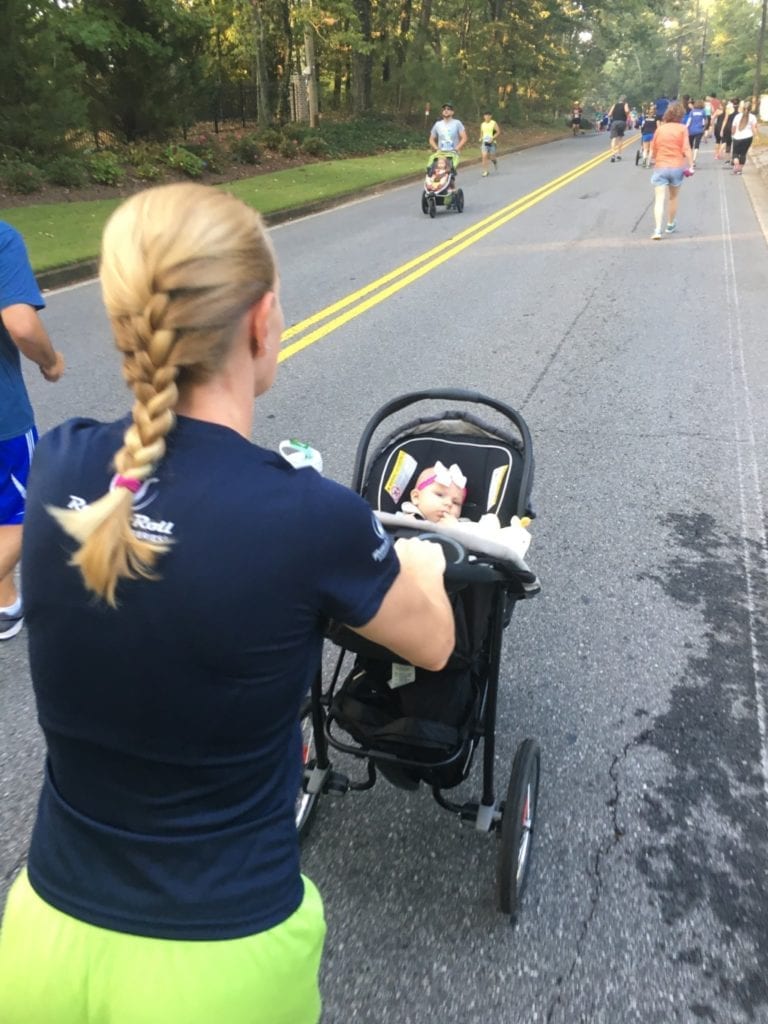Did you make a resolution to live healthier in 2019? Maybe you’ve signed up to run a race this year. Great job on taking that first step! Now for the tough part: Finding the time and motivation to train, eat well, and sustain your healthy momentum beyond that 5K, half marathon, or full marathon. With kids to take care of and maybe a job, too, making running a lifestyle is challenging but achievable. Here’s what helps me stay motivated to lace up my running shoes and sweat it out:
Set a running goal, and write it down.
Outstanding athletes like Michael Phelps write down their goals. Follow their lead and write down your running goal, too. It doesn’t have to be time-oriented. Setting a time goal can be an effective motivator – maybe you want to try a different training plan or improve upon your performance in a past race. But your running goal could be to try a different distance. Have you run a few 5Ks, but want to test yourself? Make your goal to run a 10K by year’s end. Have you enjoyed running marathons, but are now in a season of life when marathon training just isn’t possible? (Moms of littles getting up multiple times per night, I see you.) Dial it back to a 15K or 10K, and enjoy seeing how fast you can push yourself over a shorter distance.
Your goal could be to try a different kind of race. Have you only run road races? Find a trail race or sprint triathlon. The novelty of having to learn new technical skills on top of the basic running foundation you already have can be a fun challenge.

but need some variety in your exercise routine.
Hang your written goal somewhere you’ll see it often. You need to see it frequently to remind yourself that making time to regularly run is part of your goal. Last year, my husband and I trained for a half marathon in an effort to get back into a regular exercise routine after having our first child. I wrote my time goal for our half on a sticky note that I posted to my work computer to remind myself that to be the mom I want to be, but also achieve that goal. I had to have enough time on training days to drive home, fix dinner with my family, go through my toddler’s bedtime routine, go for a run AND go to bed at a decent hour. My time goal posted on my computer reminded me I needed to log off when the workday was over, no matter how much I still had on my plate, and go run.
[box type=”rounded” border=”full”]”The man who removes a mountain begins by carrying away small stones.” – Chinese proverb[/box]
Seeing your goal in writing will motivate you to move past the initial sluggishness you’ll feel when you first start training. That sentence or set of numbers will remind you why you’re still going to run on days when you really don’t feel like running. And it will make you smile when you’ve finished your race and conquered that goal.
Find a running partner with roughly the same goal.
Sometimes it’s easier to visualize yourself achieving your goal if you can picture yourself achieving it with a friend by your side. This person could be your husband, a neighbor, a coworker, or a friend, and the goal should be to run in the same race. If your running partner doesn’t want to enter the same race as you or isn’t able to, they should at least be training for a similar distance as you at the same time. There are big differences in the amount and type of training needed for a 5K vs. a half marathon vs. a marathon. If you can’t find a running partner willing to sign up for the same race as you, join a running group. You’ll find friends there who will finish your race by your side!

Agree to hold each other accountable. Tell your running buddy what your goal is, whether that’s logging a certain time or simply finishing the race. Then tell them how they can best motivate you to keep exercising. Give them permission to call you out on your excuses, and don’t get angry when they do just that. Friends want to see each other succeed, and sticking to a training plan even if you don’t feel like it is the most surefire way to successfully complete your race.
Your running buddy doesn’t have to be at the same fitness level as you, nor do you have to work out together. Sometimes it’s not possible to work out together – this person might live out of town, or their exercise schedule just doesn’t match up with yours. The important part is that you check in regularly with each other, share your struggles so you can work through a solution, and share your victories so you can celebrate together.
If your goal partner is your husband, unless you’re willing to shell out for a babysitter every time you run, you’ll probably have to work out in shifts while one of you watches your child(ren). While training for our half marathon, my husband and I went out on a practice run together just once, but because we run at different paces, we didn’t actually run together: He pushed our toddler in her stroller for a couple of miles in one direction while I ran a short loop in another direction on the same trail. I doubled back and met up with them, took over the stroller, and ran the portion my husband covered while he ran the loop I had just pounded. Teamwork made our dream work.
Which brings us to the next point:
Plan for childcare.
If your kids aren’t old enough to stay home by themselves, think through when you’ll train without leaving them unsupervised. You have more options than you might think:

- Ask your significant other, another family member, or a trusted neighbor to watch your kids while you run.
- Take your kids with you in a jogging stroller. This could be a great way to model healthy habits for your kids, as long as they aren’t too antsy and the distances you’re covering are manageable while pushing a 20 to 45-pound chariot.
- Train while your kids are in daycare/school/afterschool activities. With a little advance planning, you can fit a meaningful run into your son’s one-hour basketball practice or your daughter’s 45-minute dance lesson. During graduate school, I chauffeured a family’s kids to extracurriculars to earn gas money and simultaneously trained for a 5-mile race by doing practice runs starting from their daughter’s dance studio during her semi-weekly ballet lesson. My husband will sometimes jog the two miles to our daughter’s daycare while pushing her empty stroller, then jog home with her in it for an easy four miles. If you look closely enough, most of us have pockets of time we can use to reach our fitness goals.
- Train during your lunch break at work. Roger Bannister was a medical doctor who trained during his lunch breaks before becoming the first person to run a sub-4-minute mile.
- Join a gym that offers childcare. Seeing with their own eyes what it looks like to live a healthy lifestyle might inspire your child to join you for a race one day!
- Hire a babysitter for your training runs. This could get expensive, but your health is worth the investment. Speaking of investment:
Put your money where your muscle is, or wants to be.
When you have to pay for something, you want your money’s worth from it. Ever purchased an annual pass to the zoo or aquarium, then made sure you visited enough times to at least get the equivalent value from the individual passes you would have otherwise had to buy?
Investing in exercise works the same way. When you fork over your hard-earned cash to purchase some new running shoes, to enter a race, or to join a training group, you will be more likely to use those shoes, to train for that race, and to show up for weekly group runs because right from the start, you have some skin in the game.
Preventing injury also requires some money. You’ll want to buy some sturdy shoes to carry your feet all the miles you plan to run without getting shin splints, developing blisters or losing toenails. If you plan to train outside, you’ll need weather-appropriate clothing. And if you’re a beginner runner, it’s very much in your best interest to receive some kind of coaching, whether that’s from a personal trainer, a run group or a gym. If you’re friends with runners, ask if they can give you some tips and take you on a few practice runs to show you how to properly train in return for coffee or a post-run breakfast.
So make room in your budget as well as your schedule for exercise. Get fitted for a good pair of running shoes. Buy workout clothing that supports your girls, keeps you cool/warm depending on the season, and makes you feel confident. Purchase a training plan from a reputable coach. Join the Atlanta Track Club. Become a member of that more expensive gym or cross-training class. Register for that Disney race if it will get you moving, even if it means cutting back in another area of your budget. As with most things, you get what you pay for when it comes to running. Don’t be cheap with your body!

if you’ve invested some money in it.
Flex your muscles – and your schedule.
Be flexible about your workout schedule. There will be days when you’re supposed to exercise, but other stuff comes up and takes precedent: Your child will fall sick and you need to stay home and care for them. You might need to work overtime. Your husband/partner/babysitter can no longer watch your kids all of a sudden. Life happens. It will be okay. Cancel that day’s workout and reschedule for the next available day, then go back to your regular schedule.
Run when you want to, and when it’s most convenient for your schedule. If you’re not a morning person, don’t force yourself to get up super early to train. You will resent running and give up before long. But if your evening schedule is chaotic with dinner, homework, bath time, and prepping for the next day, maybe mornings are the best time for you to train. Think about your daily routine and fit running in when it works best for you. During the week, most of my training runs begin after my daughter’s 7:30 p.m. bedtime. Husband and I find ways to spend time together besides evenings, and I’ve learned the value of slow-cooker dinners so that everyone in our household can eat dinner when they need to.
Instead of planning to run on certain days of the week, a better approach for busy mamas like you might be to commit to run a certain number of times or a certain number of miles each week. My husband and I committed to running at least three times per week while training for our half. Two of those runs would happen during the week, and one longer run would happen on weekends. While we usually ran on the same days each week, if something came up – like a friend’s birthday celebration or a work commitment we could not get out of – we simply rearranged our schedule to complete the run on another day that week. My training plan was mileage-based, so I made sure I completed an increasing number of miles each week before tapering them back down during the two weeks before the race. If I had to cut a run short one evening because I wasn’t feeling well or because it was getting too late to safely be female and outside, I made up the mileage on my next run. Conversely, if I was feeling great during a run, I extended it, knowing I could (literally) go the extra mile now and have a buffer for the week in case something jostled my training plan later on.
On the other hand, if you know something – like a vacation or visitors coming to town – is coming up, plan your runs around it. Pack your suitcase the day before so you can get in a run first thing in the morning before you leave town. Get up early to run before your company arrives. Find out ahead of time if your hotel has a treadmill or if the concierge can recommend a running route outside, then stay on your training plan at your destination. (Reward yourself with room service when you actually go for a run!)
I once got up at 4:45 a.m. while on a work trip to exercise with the local November Project tribe, a free outdoor fitness group that meets at the crack of dawn in many cities, including Atlanta. By lunchtime I was reapplying concealer and refilling my cup of coffee for the third time, but I felt SO proud about continuing my training during the trip. Learning some new exercises and getting to sweat at a national monument site were unexpected bonuses!

A caveat to being flexible with your schedule is that Mother Nature usually isn’t as fluid. If you’re training in the summer, it’s often too hot to run during the day without overheating, so running early in the morning or in the evening is best for your health. If you’re training in winter, be aware of when it gets dark and harder for cars to see runners on the road. Wear plenty of layers as well as reflective gear. Use your best judgment and prioritize your health and safety.
Proactively practice self-care.
Get enough sleep. Take vitamins. Skip a workout (or two) if you feel yourself getting sick. Your body already needs rest and nourishment after a day of normal life activities plus exercise. If you think you’re coming down with something, trying to maintain your regular exercise schedule will only compound your oncoming breakdown. Give your immune system time and space to do its thing by taking an exercise break. You’ll miss fewer workouts if you rest for an extra day or two than if you try to power through your regular exercise schedule while your body is trying to fight off germs. In short, give yourself the grace to put your overall health first.
Enjoy race day and plan to enter another!
Whatever happens on race day – whether or not you achieve your goal – celebrate the fact that you made it to that point. You put in the hours, the sweat, the social events given up so you could get up on Saturday morning and train, and You. Made. It.
Even if I don’t reach my goal, I try to remember how lucky I am to be able to run at all, and how amazing it is that my body can do things like grow a baby while also pounding the pavement for miles and miles. I ran three races while pregnant with my tiny human, including a half marathon that I registered for pre-pregnancy specifically for its fast, flat terrain and temperate weather. Even though I couldn’t push myself toward my time goal that race, it’s still one of my favorite race experiences because I got to run it with my 13-week-old future daughter on board.

After your race, celebrate with a nap, that snack or drink you cut back on while training, and a hug for your kids for understanding how important this new running lifestyle is to you. Then keep your momentum going strong by signing up for another race! You have a running rhythm now, and there’s no stopping you, mama!

















